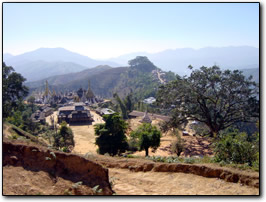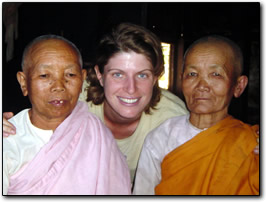
Namhsan
The next day, after waiting most of the morning at the crossroads, we found a ride with some Catholic missionaries to Namhsan. Sitting in the back on sacks of rice, we clutched the sides of the pickup as it bounced along the dusty, rutted road. The fine, dry dust, sucked over the back of the pickup, completely covered our clothes, packs and faces.
Namhsan is a row of dark teak houses strung out along a hilly ridge. We immediately ran into “Maysie”, the local English teacher who puts up guests in her home. Despite heart problems, she is a cheerful and energetic person. Walking through town with her was time-consuming but always interesting, as she would inevitably encounter friends and relatives in the street.
 |
 |
On nearby hilltop of Payangyi is a giant Buddha image with gold and precious stones. It is securely locked behind three metal gates in a thick-walled compound at the center of the monastery. Nearby Loi Sang ( Ruby Mountain ) dominates the surrounding area and the site of a large monastery. The dusty hills fanned out to the horizon. Tea is the major crop in Namhsan. Most of it is fermented, not to drink but to eat. The Burmese like to eat bitter pickled tea salad with crunchy roasted peanuts. Seeing a diorama in one of the monasteries, Maysie explained how the legend of how tea had been introduced into the area. A king from the lowlands had presented sprigs of tea to the ruler of the highlands around Namhsan. When the highland ruler accepted the gift with only one hand, not two as a sign a respect, the angry king condemned the highlanders to live from tea, but never grow rich from it. It is still true today. Most of the tea is grown, picked and processed in the highlands, but sold and consumed elsewhere. Middlemen make most of the profit, while the locals are gradually cutting down their forests to supply wood for heat required during fermentation.
 |
 |
Namhsan is the home of the Palaung people. Some of the elderly still wear their traditional costumes. They reminded us of the minority people we had seen just over the border in Yunnan. The high altitude sunlight was intense, highlighting whitewashed stupas and glinting gold decorations of the many hilltop temples in the area.
